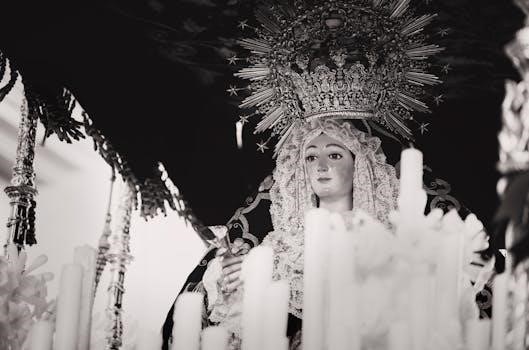Iconography, derived from Greek roots meaning “image writing,” is a branch of art history focused on the identification, description, and interpretation of images. It delves into the content of artworks, exploring themes, motifs, and symbols.

Definition and Scope of Iconography
Iconography encompasses the study of an artwork’s subject matter, including motifs, themes, and symbols. It involves classifying, describing, and interpreting these elements within their historical and cultural contexts, moving beyond mere aesthetic appreciation to understand deeper meanings.
Iconography as Image Writing
The term “iconography” literally translates to “image writing,” highlighting its focus on deciphering the visual language embedded within artworks. Like written language conveys meaning through characters, iconography recognizes that images communicate through symbols and conventions. Iconographers analyze these visual elements to “read” the story or message encoded in the artwork. This approach involves identifying specific motifs, allegories, and attributes to understand the artist’s intended meaning and the cultural context shaping the work. It extends beyond recognizing surface-level representations to uncovering layers of symbolic significance, transforming the image into a text to be interpreted and understood.
Iconography as a Method of Art Historical Research
Iconography serves as a fundamental method within art historical research, offering a structured approach to understanding the meaning and context of artworks. It moves beyond formal analysis, delving into the subject matter, themes, and symbols present in the image. By meticulously identifying and interpreting these elements, iconography provides insights into the cultural, religious, and historical values that shaped the artwork’s creation. This method involves a systematic classification and analysis of motifs, allegories, and attributes, enabling researchers to trace the evolution of visual traditions and understand the intended message conveyed by the artist to their audience within a specific cultural milieu.

History of Iconographic Practice
Iconography’s history involves the evolution of identifying, describing, classifying, and interpreting symbols in visual arts. Early studies emerged in the 16th century, shaping the understanding of artistic subject matter over time.
Early History (16th Century to Early 19th Century)
The early history of iconographic practice, spanning from the 16th to the early 19th century, witnessed the initial attempts to systematically identify, describe, and interpret the symbolic content within works of art. These early studies primarily focused on religious and mythological themes, aiming to decipher the meanings embedded within visual representations. Scholars began to compile inventories of symbols and their associated meanings, laying the groundwork for more sophisticated analytical approaches. This era saw the emergence of key texts that sought to codify iconographic conventions and establish a framework for understanding visual narratives. It marked a foundational period in the development of iconography as a distinct field of study.
19th Century Developments
The 19th century marked a significant period of development for iconography, witnessing a shift towards more systematic and scholarly approaches. Art historians began to apply rigorous methodologies to the study of visual symbols, moving beyond simple identification to explore their historical and cultural contexts. The rise of academic art history and the establishment of museums contributed to the growth of iconographic research. Scholars like Adolphe Didron focused on Christian iconography. Detailed catalogues and inventories of artistic motifs were created, aiding in the classification and interpretation of artworks. The focus extended beyond religious themes to encompass secular and allegorical subjects, broadening the scope of iconographic inquiry. This era laid the foundation for the more sophisticated iconological approaches of the 20th century.
Iconography and Iconology
Iconography focuses on identifying and describing the subject matter of art, while iconology seeks to interpret the deeper cultural and historical significance of those subjects. Panofsky played a key role.
Distinctions Between Iconography and Iconology
Iconography and iconology are related but distinct approaches to art historical analysis. Iconography primarily involves identifying and classifying the subject matter, motifs, and symbols within a work of art. It focuses on what is depicted, recognizing established visual conventions and their meanings. Think of it as the descriptive stage, pinpointing recognizable elements like a lamb symbolizing Christ or a dove representing the Holy Spirit.
Iconology, on the other hand, goes further. It delves into the deeper cultural, historical, and philosophical context to interpret the underlying meaning and significance of those iconographic elements. It explores why those particular symbols were chosen and what they reveal about the artist, the patron, and the broader cultural values of the time.
Panofsky’s Contribution to Iconography
Erwin Panofsky significantly shaped the field of iconography with his systematic approach to understanding meaning in visual arts. He formalized the distinction between iconography and iconology, providing a framework for art historical analysis. Panofsky proposed a three-tiered system⁚ pre-iconographical description (identifying basic forms), iconographical analysis (recognizing themes and concepts using art historical knowledge), and iconological interpretation (understanding the underlying cultural context and worldview).
His work emphasized the importance of considering the historical and cultural milieu in which a work of art was created. Panofsky argued that true understanding required moving beyond simple identification to grasp the deeper symbolic significance embedded within the artwork and its relation to the broader cultural landscape.

Specific Studies in Iconography
Specific studies in iconography involve analyzing motifs, themes, and types within artworks. This includes classifying themes, attributes, symbols, and allegories, tracing their historical development, and focusing on visual traditions and image formulas.
Analysis of Motifs, Themes, and Types
The analysis of motifs, themes, and types forms a cornerstone of iconographic study. This involves identifying recurring visual elements (motifs), overarching ideas (themes), and standardized representations (types) within artworks. Understanding these components allows for a deeper interpretation of the artist’s intent and the cultural context in which the work was created.
Iconographic analysis includes reading images critically in relation to social and cultural values. It is often understood as a visual language, teaching viewers about particular cultures. Tracing the transformations and imitations of these elements reveals artistic traditions and their evolution. This detailed examination helps unravel the complex layers of meaning embedded within visual representations.

Iconography in Different Cultures
Iconography varies significantly across cultures, reflecting diverse belief systems, historical contexts, and artistic traditions. Examining these differences reveals unique cultural perspectives and symbolic languages embedded within visual representations worldwide.
Christian Religious Iconography
Christian religious iconography is a rich visual language employing specific symbols to represent figures, events, and concepts within the Christian faith. The lamb symbolizes Christ, the dove represents the Holy Spirit, and the cross signifies sacrifice and redemption. These images convey complex theological ideas.
Saints are often depicted with attributes indicating their lives or martyrdoms. For example, Saint Peter holds keys, representing his role as the keeper of Heaven’s gates.
Understanding Christian iconography requires knowledge of biblical narratives, hagiography, and theological traditions. Visual elements serve as a powerful means of communicating religious narratives and doctrines to believers, fostering devotion, and reinforcing cultural values within Christianity. This iconography evolved significantly throughout history.
Non-Western Iconography
Non-Western iconography encompasses the diverse visual symbol systems developed across cultures outside the Western tradition. These systems are found in various forms of art and visual communication, reflecting unique cultural values, beliefs, and narratives.
For instance, Hindu iconography employs deities with multiple arms, each holding symbolic objects representing different aspects of power or nature. Buddhist iconography features the Buddha in various mudras (hand gestures), each conveying specific teachings or states of enlightenment.
Analyzing non-Western iconography requires a deep understanding of the specific cultural context, religious beliefs, and artistic conventions. These systems often differ significantly from Western traditions, demanding careful consideration of their distinct symbolic meanings and interpretations. Understanding facilitates intercultural communication.
Applications of Iconography
Iconography extends beyond art history, finding applications in diverse fields like semiotics, media studies, and archaeology. It aids in understanding visual communication, interpreting cultural meanings, and deciphering symbolic representations across various contexts.
Iconography in Semiotics and Media Studies
Iconography plays a crucial role in semiotics and media studies by providing tools to analyze visual communication. It helps decipher the meanings embedded within images and symbols used in media content, such as advertisements, films, and digital interfaces. By understanding the iconographic conventions employed, researchers can uncover the underlying messages and cultural values being conveyed. Iconography allows for a deeper examination of how media shapes our perceptions and influences our understanding of the world. It provides a framework for interpreting the visual language used to construct narratives, communicate ideologies, and reinforce social norms. This analytical approach enhances our critical engagement with media and fosters a greater awareness of its impact. Furthermore, in an era dominated by visual culture, the principles of iconography have become ever so important.
Iconography in Archaeology
Iconography serves as a vital tool in archaeology, enabling researchers to interpret the symbolic meaning of artifacts and images from past cultures. By analyzing recurring motifs, symbols, and narratives depicted on archaeological finds, such as pottery, sculptures, and cave paintings, archaeologists can gain insights into the beliefs, rituals, and social structures of ancient societies. Iconography helps to reconstruct the worldview of past peoples, shedding light on their religious practices, political ideologies, and daily lives. Through careful examination of visual representations, archaeologists can decipher the stories and messages that these images were intended to convey. The use of iconography in archaeology allows for a more nuanced understanding of material culture and the people who created it, enriching our knowledge of human history and cultural diversity. This field of study also offers an opportunity to look at the potential for new discoveries.
